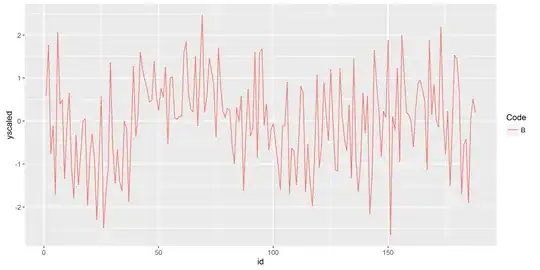Suppose I have $m$ individuals from a population (not necessarily people: here "individuals" may also indicate machines of common design). $m$ is small, say, 10. For each individual I measure some quantity as a function of time: the number of time observations (the sample size) is different for each individual, i.e., $N_1,\dots, N_m$. EDIT: the sampling rate is the same for all individuals.
The quantity in question doesn't (seem to) exhibit some trend: it randomly oscillates around the time mean, which may differ from individual to individual, with a standard deviation which is roughly constant with time (for a given individual). Just to be clear, the oscillation doesn't seem to be harmonic: it's random, but its amplitude doesn't seem to depend on time.
I have two goals:
- I want to estimate the time mean and standard deviation of the population. How do I combine the time series from the different individuals to do that? Do I need to take into account the different sample sizes, and if so, how?
- I want to estimate the time mean and standard deviation for a new individual, not observed. In other words, I would like to compute a prediction interval for the time mean and the time standard deviation. How do I do that with time series?
EDIT: here is a plot of a single time series for one individual.
Looking at the standardized time series, it could seem that the variation is not small. However, consider that the oscillation is much smaller than the time average: I cannot show the actual values, but for each individual $j$ the sample coefficient of variation
$$V_j =\frac{\bar{X}_j}{S_j} \approx 6 \cdot 10^{-4} $$
where with $\bar{X}_j$ and $S_j$ I denote
$$\bar{X}_j = \frac{\sum_{i=1}^{N_j} X_{ij} }{N_j}, \quad S_j =\sqrt{ \frac{ \sum_{i=1}^{N_j} (X_{ij}-\bar{X}_j)^2 }{ N_{j-1} } } $$
EDIT2: following GeoMat22's comments, I understand that I could compute $\bar{X}_1,\dots,\bar{X}_m$ and $\frac{S_1}{n_{eff,1}},\dots,\frac{S_m}{n_{eff,m}}$ for each individual. I still miss two steps: how to compute in practice $n_{eff,j}$ for each individual, and how to combine all these data to get an estimate and a standard error for 1) the time mean of the population and 2) the time mean of a new, unobserved, individual.
